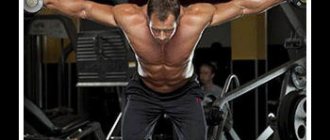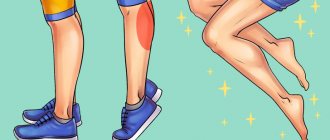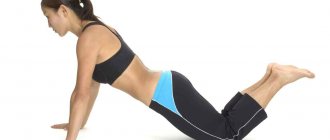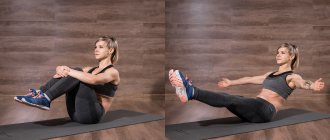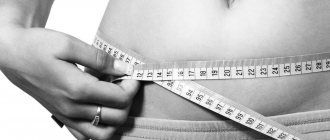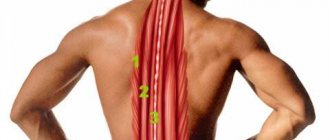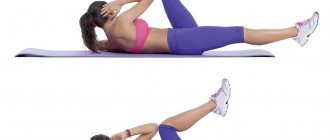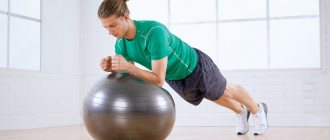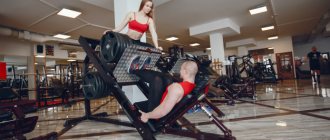The benefits of exercising on a fitball
The peculiarity of the fitball, which makes it universal, is that during exercises with it the motor, vestibular, visual and tactile apparatuses are simultaneously involved in the work. Exercises with balls are safe and fun. But the most important thing is the undeniable benefits of exercising with fitball for the body. What effect can you get by working with a gymnastic ball?
- Correct posture. Any exercise with a ball strengthens the back muscles without overstraining them. Due to the need to maintain balance, the work includes types of muscles that are not used in other types of training. The muscle corset around the back is strengthened.
- Training the vestibular apparatus - over time, the ability to maintain balance automatically is developed, and coordination of movements improves.
- Improving the functions of the cardiovascular system and respiratory system by activating blood supply.
- Strengthening the nervous system. Fitball exercises lift your spirits, help you relax and relieve stress.
- Development of flexibility and plasticity. During the exercises, all muscles are stretched, joints are unloaded and stretched, and clamps are removed.
- Accelerates metabolism and burns fat. Comprehensive exercise programs with a fitball help you lose excess weight. For women, the benefit of training is the opportunity to get an ideal sculpted figure, beautiful abs, elastic buttocks, and remove fat deposits from the hips.
On a note. To get the first benefit from a Swiss ball, you just need to sit on it: this already “works” for beautiful posture! In Scandinavian countries, many people use this ball instead of a chair. This is such an unobtrusive benefit. And if you also jump lightly on the fitball, the release of serotonin, the hormone of happiness, into the blood will ensure a good mood.
Training legs
- We recommend it to everyone who wants to learn how to properly do exercises to lose weight in the abdomen, thighs, and buttocks with a fitball. Lie on your back and grasp an exercise ball using your thighs and shins.
- Squeeze the ball towards your buttocks and slowly return to the starting position after a short pause.
- When squeezing your legs, exhale; when relaxing, exhale.
Jumpers: useful, harmful or “not at all”?
I can immediately say for myself that there will be no such device in my house. But we cannot always regulate this. There are relatives and friends who will give gifts, and then we will be faced with the question “Will it do any harm?”
Much has already been written about the possible harm from such a device. It's all true, but it can be made useful by meeting a few conditions.
Condition one: you can “pack” a child into jumpers only when the child is already standing quietly. Almost on his own and only slightly holding onto the support with his hand. It is too early to introduce even a well-sitting but not standing child into jumping.
Condition two: while sitting in the jumpers, the child should not just touch the floor with his feet, but reach so that his legs are bent at an angle of 120 degrees. As shown in picture "A". In this case, the child will lift himself up to jump. And the jump won't work. He will lift himself up and bend his legs.
If you adjust the height, as in Figure “B,” then in such a situation you will be able to collect the maximum number of owls. I must say that this is exactly how the majority hang themselves. It is in this position that the child will jump on his toes and land on straight legs.
Back and arm workout
People of almost any age and health status can train with a fitball. However, there are still a small number of contraindications for such sports equipment.
Exercises on a fitball for weight loss are contraindicated if:
- Pathological process of internal organs.
- Intervertebral hernia.
- Severe diseases of the cardiovascular system.
- Pregnancy up to 12 weeks.
If you are pregnant or have any illness, you should definitely consult your doctor before starting training with a fitball.
Exercises on a fitball for losing weight on your arms and back do not load your spine. They strengthen your back muscles, pump up your arms and improve your posture.
boat
The exercise not only successfully works the back muscles, but also helps strengthen the lower abdominals.
Sequences:
- Lay out the mat. Place yourself on it with your stomach down.
- Do not squeeze the ball too much between your feet.
- Straighten your arms and extend them forward.
- As you inhale, raise your arms and legs up without bending them.
- Hold this position for 1-2 seconds.
- When exhaling, take the original position.
Training with a fitball and strength equipment successfully works the muscles of the arms and chest.
Subsequence:
- Place your back on a fitball, bending your knees.
- Take dumbbells weighing 1-2 kg.
- Bend your elbows.
- As you inhale, bring your elbows together in front of your chest.
- As you exhale, move them apart.
Who is fitball training suitable for?
Age, physiological characteristics, excess weight and fatigue are not a hindrance to exercise with fitball. Balls are used in gyms and rehabilitation centers, and at home. Fitball training is suitable for everyone who cares about their health. Exercises with a gymnastic ball are needed:
- for regular training to strengthen the body, muscles, lose weight, improve posture, figure, and general well-being;
- for pregnant women: training prepares muscles for childbirth, relieves tension from the lower back, improves blood circulation;
- for children of any age - to train endurance, strengthen muscles, coordinate movements;
- for newborns, starting from the 2nd week of life - to strengthen the vestibular apparatus, relieve muscle hypertonicity, improve blood circulation;
- for older people to improve tone, improve coordination, blood circulation;
- during the rehabilitation period when recovering from injuries;
- as a relaxation and anti-stress therapy after a hard day.
The Swiss ball is even used in maternity hospitals: swinging on the fitball and rolling it from side to side relieves pain during contractions. Many pediatricians recommend rocking the baby while bouncing on a ball: this simultaneously calms the baby and massages the mother’s lower back muscles.
Useful fitness tips from trainers for exercising with a ball
These recommendations will be useful for those who decide to start exercising with a gymnastic ball. They can be boiled down to the following points:
- Replacing quiet cardio exercises with dosed training sessions.
- Placing emphasis on internal muscles.
- Don't slouch.
- Gradual increase in range of motion.
- The pace of movement is as fast as possible.
- Predominant use of complex exercises.
- Periodic change of grip.
- Experiment by loading only one side.
- Do push-ups consistently.
- Gradual transition to heavier weights. It should be 70% of your maximum capabilities.
- Exercises with a ball for the abs and buttocks involve using the correct technique.
- Use of explosive loads.
- Recovery with light exercise.
- After training, consumption of milk chocolate is recommended.
If you are tired of going to the gym or simply don’t have time for it, exercise with fitball is a good alternative to such training. You can do all this at home, even combining classes with watching your favorite TV series. This will help correct your figure, pump up your muscles, and the girl’s figure will become worthy of the admiring gaze of men.
Can a child jump on a trampoline and fitball?
To begin with, I would like to immediately dismiss two factors that will interfere with the determination of “beneficial or harmful”:
- Possibility of injury. Injury can also occur on a flat lawn or on stairs. There is always and everywhere a risk - so we write off this point from the argument.
- Stimulation. This is a situation where the mental characteristics of the child come first, and not possible harm to the musculoskeletal system. We will only consider situations of child activity and benefit or harm.
If we are talking about the age of 2-3 years, then it is at this age that the child learns to jump, land and jump. Accordingly, moderate use of a trampoline, jumpers and fitball will only prepare the child (his muscles and joints) for such a load.
You will not be able to stop the child, and he will constantly jump off the curb, the bed and land repeatedly on a hard surface. Thus, you receive a shock load on the joints. At the same time, you need to understand that this load will fall not only on the joints of the legs, but will also spread to the pelvis and spine.
Therefore, I can say that it is useful for a child to jump on a trampoline, jumping jacks and a fitball at this age, since all these exercise machines soften the load and make it dosed. Then a child who has learned to absorb shock on a soft surface will be much safer when jumping onto the floor or ground.
My conclusion is very simple: anything is possible and any child’s activity is useful if it does not lead to increased stress. And if the child is also active and has a need to move, then this is also a way to let off steam. You just need to remember that these are high-risk areas and be aware of this.
And, of course, a child can be seriously injured by these shells. But I cannot say that this load will in any case affect the structure of the child’s joints. This simply cannot happen if everything is normal for the child initially. This only happens with excessive load, and this is already a sport.
Are you ready to take risks? Let your child jump. And if you are very worried about this, then... don’t let your child do it. True, later at school it will be a little harder for your child to jump over the goat, but he will have to. Body weight will increase, and the injury may be much more serious. A reasonable approach to the load - and even walking on a tightrope becomes useful. Children walk on curbs at 5 years old for a reason.
Single leg lunge
Place the fitball on the floor, stand with your back to it and take a step forward.
Take your left leg back and place it together with your ankle on the fitball so that your heel points to the ceiling. The leg brought back should be bent.
Start slowly bending the knee of your right leg, lowering your hips towards the floor, pause for a couple of seconds and also slowly return back. The fitball can roll back and forth or slightly to the side.
You can make the exercise more difficult using dumbbells.
Perform the exercise about 7-12 times and change legs. About 3 sets should be performed on each leg.
What muscles are involved?
Let's talk about the buttocks. The gluteal muscles of our body consist of three parts:
- Large ones - located on the back surface of the pelvis and are responsible for convexity and relief;
- The middle ones are located on the sides of the pelvis and are responsible for the beautiful line of the hips;
- Small - attached next to the middle muscles and perform the same functions.
By training each of them, doing exercises for the buttocks on a fitball, you will help your butt become convex, toned and elastic.
It is important to understand that training on a fitball is not isolating. This means that in addition to the glutes, many other muscles will be involved. Below are the most effective exercises with a fitball for the buttocks, thighs, abs and lower back muscles.
The best ball exercises for buttocks and thighs
Fitness using a fitball is one of the easiest and least traumatic activities. Suitable even for people with back problems or during the recovery period after injuries. You can exercise with a fitball at any age, during pregnancy and after the birth of a child, at any level of physical fitness. The most popular are planks with emphasis on a fitball, lifting it with your feet, or squats with a ball. Any standard exercise can be varied and complicated with the help of this sports equipment.
Hyperextension
How to do the exercise correctly:
- Lie with the middle of your stomach on the fitball, take a relaxed position, as if hanging down.
- Place your feet on the floor and fold your arms across your chest.
- Take a breath.
- The torso should be extended in a straight line.
- Exhaling, return to the first point.
For beginners, it is recommended to perform 10 repetitions in three sets.
Thanks to intense movements on the ball and the simultaneous inclusion of large muscles in the work, you can effectively work out the main problem areas: buttocks, back of the arms, inner thighs, waist.
Technical points in the exercise:
- Press the ball firmly with your lower back against a horizontal, stable surface.
- Exhaling, slowly squat, rolling the ball. Knees come forward.
- Fix in the lower position, maintaining tension in all muscles.
For untrained athletes, it is recommended to start with 10 squats in three sets.
Fitball exercises are also useful for young mothers to restore their usual slimness. Thanks to the soft, elastic surface of the ball, girls can perform simple exercises in the first months after the birth of the baby.
Jumping
Training Features:
- Sit your butt on a fitball.
- Do jumping movements without lifting your buttocks.
- The faster you do jumping jacks, the more calories you will burn and the better your gluteal muscles will work.
Beginners are recommended to start with 3 minutes. Advanced athletes jumping for 5-7 minutes a day achieve impressive results in the form of pumping up beautiful legs and buttocks.
With the help of a fitball, you can conduct intense aerobic training aimed at getting rid of extra pounds.
Gluteal bridge
The nuances of the correct bridge exercise technique:
- Lie on your back and press your feet firmly against the ball, raising your legs and bending them at the knees.
- Inhaling, slowly lift your pelvis up, fix the position, tensing your muscles.
- Exhaling, slowly return to the starting position.
This type is more suitable for advanced athletes who are physically prepared. Perform 12-15 repetitions in three passes.
By systematically performing exercises on a gymnastic ball at least three times a week, you will achieve what you want - your waist will become thinner and your figure more toned.
Subtleties and correctness of the reverse bridge:
- Lie with your back on the floor.
- Extend your legs and place them on top of the ball.
- Hands lie freely on the floor.
- As you inhale, lift your pelvis up, while simultaneously rolling the ball closer to you with your feet.
- While raising your legs, tense the muscles of your butt, thighs and abs as much as possible.
- Exhaling, return to the starting position without touching the floor with your pelvis.
This activity is suitable for people with well-trained muscles and advanced athletes. Perform from 12 to 20 repetitions in three passes.
Perform a set of exercises on a fitball regularly, at least three times a week, alternating a day of exercise with one or two days of rest.
Practicing with a fitball affects muscles no worse than exercise machines. The need to maintain balance and control every movement develops coordination and flexibility. They force even small muscles to work that do not receive stress when performing other techniques.
The exercises are not isolated, because in addition to the target muscles, the hips, abs and legs receive the load.
1. Hyperextension
It is better to start training with hyperextensions in order to additionally pump up the iliocostal muscles, the middle and lower back, as well as the hamstrings.
- Lie on the ball with your stomach, hold your bent arms in front of you or behind your head, rest your straight legs on your toes, relax your back.
- As you inhale, tighten the muscles of your back, buttocks and abs and stretch into a line. While maintaining balance, feel each muscle.
Start with 10 reps and work your way up to 20.
The technique itself is not complicated, so pick up dumbbells.
- Place your feet slightly forward and press your shoulder blades against the exercise ball.
- With a tense press, lower your pelvis down horizontally to the floor, rolling the sphere with your back.
- Feel the tension in your hips and, raising it vertically, straighten up (12 times).
- Stand against the wall with your left side, press the ball with your forearm.
- Extend your left leg behind your right and leave it hanging.
- Perform a series of ball roll squats.
Change the supporting limb and duplicate the movements for the other side.
- Place the drumstick on the ball.
- Press the instep of your foot against the surface.
- Bend your leg at an even angle and squat 20 times.
- Perform classic squats while holding the sphere in front of you.
- In the negative phase, lower it towards your feet.
- In a positive way, lift it above the top of your head.
Rifles
This is one of the best exercises for the buttocks on a fitball.
- Take a position lying on your back, resting your heels on the sphere.
- Raise your pelvis and roll it forward and backward.
Option #1. Sit on the ball, point your knees towards each other, fold your arms on your chest. Squeeze and unclench it with your thighs as you inhale and exhale.
Option #2. Lying on the floor, squeeze your ankles. Using the force of your stomach and buttocks, lift your pelvis upward, holding the static position for 5 seconds.
Jumps No. 3. Sitting on top of the ball, squeeze it with your thighs and, without lifting your feet from the floor and buttocks from the surface, perform a series of rhythmic jumping movements.
At the end of this block, do a technique to firm up your buttocks.
- Lie on your back, wrap your ankles around the ball.
- By tensing the gluteus maximus and abdominal muscles, lift your limbs, and after a 3-second delay, return them to the IP position.
Repeat 13 times.
- In a lying position, throw your feet back into the center of the ball, lift your body and at the same time straighten your legs bent at the knees.
- Twist your lower back upward, align your body and shift the fulcrum to your shoulder blades.
- Pause briefly and lower your body to the floor.
In the complicated version, in addition to the target muscles, the abs receive intense load.
- In a lying position, place your feet on the ball, raise your middle part of the body, and roll the fitness ball to your hips.
- Hold for 50 seconds, maintaining balance with your arms extended along your body.
- Then use your feet to send the projectile to the starting position.
To make it more challenging, place discs on your hip bones or lift one leg vertically.
How to choose a fitball?
The effectiveness of exercises with a fitball depends not only on the intensity of the exercise, but also on the correctly chosen size of the ball. It will be inconvenient to exercise with a small one, and with a large fitball there is a high probability of falling and getting injured. There are two options for choosing a projectile.
- Sit on the ball with your legs together in front of you, back straight. The inclination of the knee joint should ideally be 90⁰, maximum 110⁰. If the slope is an acute angle, the ball is too small for you.
- If it is not possible to “try on” the ball, and the purchase is made remotely, focus on the following parameters:
- for newborns, children, teenagers and adults up to 1 m 52 cm, a ball 45 cm in diameter is recommended;
- people with a height from 1 m 52 cm to 1 m 64 cm - 55 cm;
- with a height from 1 m 64 cm to 1 m 80 cm - the diameter of the ball is 65 cm;
- if an athlete is taller than 1 m 80 cm, buy a 75 cm fitball;
- For those who are taller than 1 m 90 cm, balls with a diameter of 85 cm or more are suitable.
For gym workouts, choose a classic smooth ball. Beginners, children and pregnant women should purchase a fitball with “horns” for greater confidence. The “pimply” massage device works more deeply with the muscles: it is good for combating cellulite and neurological pathologies.
Important! When choosing a fitball, you need to pay attention to the maximum weight it is designed for. In addition, the ball should not be too elastic or soft, the effectiveness of the exercise depends on this - the degree of its inflation should be adjusted.
The cost of gymnastic balls depends on the diameter of the projectile, material of manufacture, modification and brand of the manufacturer. On average, this ranges from 700 rubles for the smallest ball and up to 1800-2000 for fitballs of large diameters.
If you are in doubt about purchasing a gymnastic ball because it will take up a lot of space in your apartment, then we hasten to reassure you. A fitball in a deflated state can easily be placed in a small box, and is inflated using a pump for 5-10 tons. There is no need to worry about safety: the ball will not burst or explode if damaged, but will slowly deflate. Most modern fitballs are equipped with an anti-explosion system. This indicates that the ball is protected from sudden breaks.
When purchasing a fitball, pay attention to the presence of a pump in the kit. If you have a pump at home (including a bicycle pump), then you don’t have to worry about this. If not, then it’s better to choose a ball with a pump included. Before using the fitball for the first time, it is advisable to inflate it once (approximately 70-80% of the maximum volume), hold it for several hours, deflate completely and then inflate it again to the maximum volume.
Please note that the more you inflate the ball and the tighter it is, the more difficult it will be for you to perform the exercises and the more stress your body will receive. At first, while you are just adapting to a new apparatus, you can not fully pump it up.
Fitballs come in different diameters from 45 to 95 cm. The most popular sizes are 65 and 75 cm. Most often, people of average height choose these types of balls.
In order to make sure that the fitball size is suitable for you, we recommend performing this test. Sit on the ball and look at the angle formed between your shins and thighs. If the projectile suits you, then the angle should be 90-100°. In this case, the feet should be completely on the floor. If the angle between the shin and thighs is sharp, then the fitball is too small for you.
If you do not have the opportunity to try on a gymnastic ball, then try to focus on the ratio of height and diameter of the ball:
- 150-160 cm – diameter 55 cm
- 160-170 cm – diameter 65 cm
- 170-180 cm – diameter 75 cm
- 180-190 cm – diameter 85 cm
How to train with a fitball?
In addition to the stability ball, you'll need a mat and enough space around you to do the exercises. You can choose just the exercises below that you like and include them in your training, or you can try all 10 of them.
Try HIIT (High Intensity Interval Training), for example:
- perform one exercise for 30 seconds and then take a 30-second break,
- move on to another exercise and once you have completed them all, one set is complete,
- if you include all 10 exercises, 1 set will last 10 minutes,
- take a 1-2 minute break between approaches,
- perform 2-3 approaches in this manner.
Or circuit training:
- perform 8-20 repetitions of each exercise, one after the other,
- when performing isometric exercises such as the plank, try to remain in this position for at least 20 seconds,
- perform 2-3 approaches in this manner,
- take a 1-2 minute break between sets.
Top 3 Ball Moves for Beginners
These movements are quite simple to perform and do not require serious physical training. They are quite suitable for beginners.
The exercise is suitable for both beginners and advanced athletes. The primary muscles involved are the iliocostal, lumbar and mid back muscles. Additionally, the gluteus maximus and hamstring muscles are tensed. The ball exercise differs from the classic hyperextension for the buttocks in that, among others, it involves many more stabilizer muscles.
In the ranking of the TOP 10 exercises for the buttocks, “Hyperextension” takes 6th place.
Technique:
- Starting position - lie on your stomach on the ball, arms bent behind your head, legs straight with support on your toes, looking down, your back completely relaxed (as if hanging from a gymnastic apparatus);
- As you inhale, the back muscles straighten and the body stretches into one straight line, the lower back is slightly tucked so as not to overstrain it;
- As you exhale, we return to IP again.
The difficulty of these actions lies in maintaining balance and coordination.
You should start with 10 repetitions in 3 sets. You can gradually increase the number of repetitions to 20-25.
You will see 5 more types of hyperextension here.
The work is aimed at working out the butt and the front of the thigh. The difficulty is easy; if you wish, you can weigh yourself down with dumbbells or do squats on one leg. There are 7 more types of squats for the gluteal muscles; special attention should be paid to squats with dumbbells.
Also check out our 30 Day Squat Challenge.
Technique:
- The starting position is to stand with your back to the wall and press the ball tightly against it with your lower back. The legs are set slightly forward and shoulder-width apart;
- Tighten your abs, take a breath and, keeping your balance, squat down, your thighs should be parallel to the floor. Stay at the bottom for a few seconds, feeling all the tension in your buttocks;
- As you exhale, return to the starting position.
The ball should roll up and down along your spine. Be sure to watch your lower back; it should be pressed tightly against the gymnastic instrument. For greater load, perform this exercise with dumbbells.
You need to do 15-20 repetitions for 3-5 approaches.
Why training with a fitball is worthy of your attention?
A fitball is a practical piece of sports equipment that you can purchase and easily store at home. You just need to inflate it using a pump, and you can start training. Fitball will also be appreciated by people who have sedentary work, which often causes back problems. When you sit and swing on an exercise ball, you deeply engage the muscles of the stabilizing system (core), which has a positive effect on body posture. However, it is not recommended to sit on a stability ball all day because there is a risk of overloading the activated back and abdominal muscles. To start, 30 minutes a day will be enough. [1-2]
However, if you want to get the most out of this exercise equipment, you have to do more than just sit on it. You should include it in your training plan. Fitball will show how developed your balance and coordination skills are. If this is your weak point, don't worry. By regularly training with the ball, you can easily gradually improve your performance. [3-4]
By training with a stability ball, you also engage and strengthen the core muscles of your entire body , which are sometimes called the spinal stabilization system. This system is crucial not only for correct body posture during daily activities, but also when playing any sport. Strong and developed core muscles will be useful when lifting weights, running and other favorite sports activities. At the same time, you will support the body's natural defenses against injury. Depending on what exercises you decide to include in your workout, you will be able to target other important parts of your body. Thus, the fitball also allows you to train the muscles of the arms, back, and legs . [5–6]
If you're looking for other ways to strengthen your core, try the workout in our article What exercises can you do with training loops? Learn about effective exercises for all muscle groups
Fifth exercise
The following exercise is suitable for strengthening the oblique muscles of the abdomen and inner thigh. You need to lie on your back, legs bent at the knees with a ball sandwiched between them. Hands are behind the head, elbows pointing to the sides. We lift our shoulders off the floor and do crunches, stretching our elbow to the opposite knee.
A video for pumping up the buttocks, thighs and abs is given below. Be sure to watch it.
See other exercises for the abs and buttocks on a fitball on our website in other articles.
